#michael kogge
Explore tagged Tumblr posts
Text
Sabine and Ezra in the Star Wars Children’s Books, a master post with a mountain of evidence supporting the Sabezra ship. 😉




Part One: https://www.tumblr.com/jedimandalorian/747333236931379201/part-one-of-three-dear-church-of-ezrabine
#sabine wren#ezra bridger#star wars#sabezra#ahsoka series#star wars rebels#ezrabine#Michael Kogge#Pablo Hidalgo
40 notes
·
View notes
Text

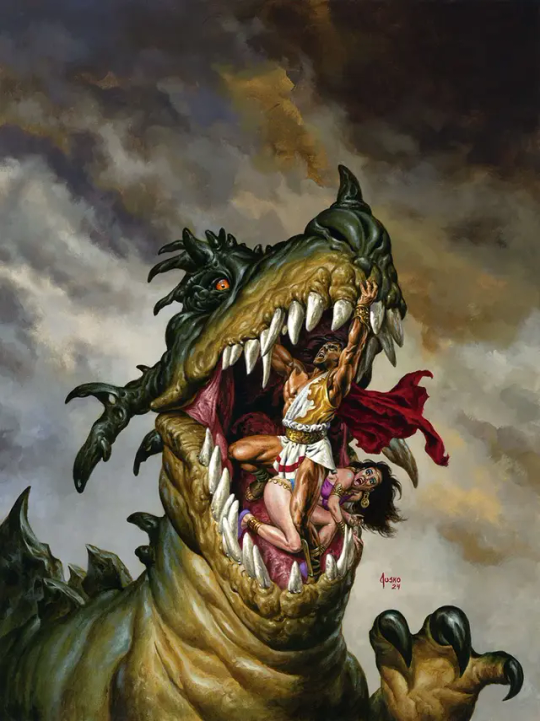
The Savage Sword of Conan #5 by Jason Aaron, Michael Kogge, Geof Isherwood and Dan Parsons. Variant cover (1) by Alex Horley. Main cover (2) by Joe Jusko. Out in October.
"A NEW KING CONAN ARC BEGINS BY JASON AARON! THE SAVAGE SWORD OF CONAN continues its triumphant return from Heroic Signatures and Titan Comics! Featuring the first chapter of an epic KING CONAN two-part comic from Eisner Award-winning writer JASON AARON and artist GEOF ISHERWOOD, a YOUNG CONAN tale from writer MICHAEL KOGGE and artist DAN PARSONS, colossal covers from JOE JUSKO and ALEX HORLEY, astonishing art pin-ups, and more!"
#the savage sword of conan#savage sword of conan#conan the barbarian#king conan#titan comics#jason aaron#michael kogge#geof isherwood#dan parsons#joe jusko#alex horley#variant cover#comics
23 notes
·
View notes
Text








A year ago today was such a blast with all of you in Burbank, CA! We'll be back in the Los Angeles area in 2025 for another convention celebrating the Expanded Universe!
Photos by Thor Parker / Bekah Marie Photo
#Darth Bane#Mission Vao#Cade Skywalker#Mara Jade#Mara Jade Skywalker#Pazaak#Mike Hansen#Corinna Bechko#Max Rebo#Luke Skywalker#Michael Stackpole#astromech droid#Jason Fry#Henry Gilroy#Abel Pena#Michael Kogge#lightsaber#Star Wars Books#Star Wars Comics#Star Wars Legends
16 notes
·
View notes
Text
Preview: Savage Sword of Conan #5 (of 6)
Savage Sword of Conan #5 preview. The first chapter of an epic King Conan two-part comic from Jason Aaron! #comics #comicbooks
#comic books#Comics#dan parson#geof isherwood#heroic signatures#jason aaron#joe jusko#michael kogge#savage sword of conan#titan comics
0 notes
Text
The Rise of Skywalker junior novelization is a solid adaptation
#TheRiseofSkywalker junior novelization is a solid adaptation #StarWars
I’m not going to sit here and act like The Rise of Skywalker is my favorite Star Wars film. I went to see it three times in theaters, and I have not watched it at home once over four years later. So, yeah. But, I recently read the junior novelization of the film by Michael Kogge, and it’s pretty good! I’m obviously not the target audience of a junior novelization, but I thought it was well done.…

View On WordPress
0 notes
Note
Hello! Thank you again for answering my question about Jedi quarter doors having locks. I was wondering if personal photos are a thing in the gffa? I think I remember Ezra maybe having a picture of his family and there are of course paintings and portraits of people, but I can’t remember of personal photos are a thing. Thank you in advance if you end up answering!
Hi! This one took me a bit, because I really had to think about it, and ultimately I've come to the same conclusion: It's kind of up to you! You're right that Ezra had a holo of his parents but I don't think we've ever seen it in universe as anything but a holo. (You can find it as a picture in some reference books, but they're not in-universe.)

In Attack of the Clones, there are a couple of deleted scenes where they go to Padme's house on Naboo and all the pictures on the wall (including one in the dining room, as well as Padme's bedroom) are holos as well:
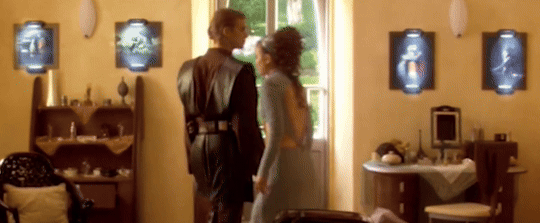
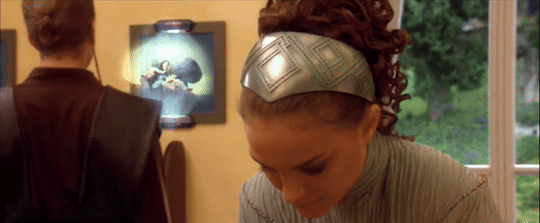
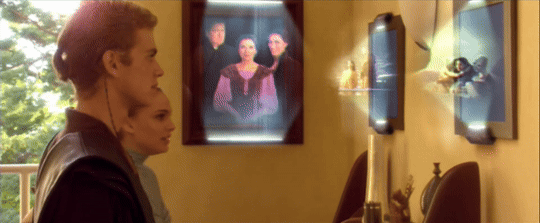
On the other hand, Hera has the physical painting of her family and Luke and Rey had the old Jedi physical books/texts, so we know physical forms do exist! But we don't really see that much paper in the GFFA, sure, it exists in books/comics as flimsi (or flimsiplast), but we don't really actually see it much, which-- oh, wait, okay, so you have just sent me down an awful rabbit hole here, because! I always assumed that flimsi and paper were the same thing--and they probably are to most authors in Lucasfilm, I'd bet--but the novel "The Rebellion Begins" by Michael Kogge says they're actually different things:

Which blew my mind! But doesn't answer the question, other than that paper and flimsi were pretty rare, but not totally unheard of. So that made me think, okay, personal photos were a thing, because physical material seemed to be seen as extremely rare/outdated, but then I remembered, there are posters plastered all along the walls in The Clone Wars in the Underworld:

I guess we can't say for sure those are paper or flimsi, but they sure do look like it to me. And the animators probably weren't thinking that hard about worldbuilding (flimsi has only ever appeared in the comics/novels, I think...?) so I think it's a mistake to try to insist that Star Wars is coherent when it comes to these things, and thus that ultimately means: Up to you! We've never seen paper/flimsi personal photos in Star Wars that I can remember, the two instances we do have in visual media are digital pictures, but there's content in TCW that such a thing could exist if you wanted, so pick whichever works for you! If pressed, I would say that someone could go out of their way to make a paper/flimsi photo of someone, but it would be an effort on their part and considered hundreds of years out of date, but, you know, some people like old-fashioned, less efficient things because they like the feel of them!
118 notes
·
View notes
Text
Star Wars: Absolutely Everything You Need to Know (Canon)
"Star Wars: Absolutely Everything You Need to Know" is a Canon reference book written by Adam Bray, Kerrie Dougherty, Cole Horton, and Michael Kogge. The book was released by Dorling Kindersley on Separatist 4, 2015.



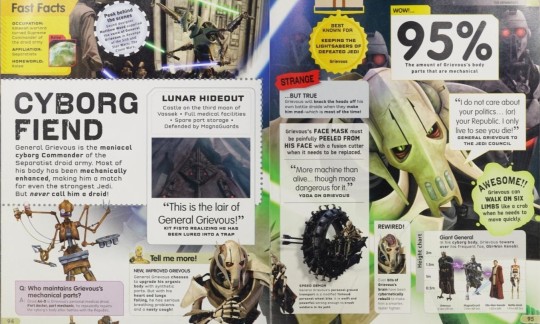
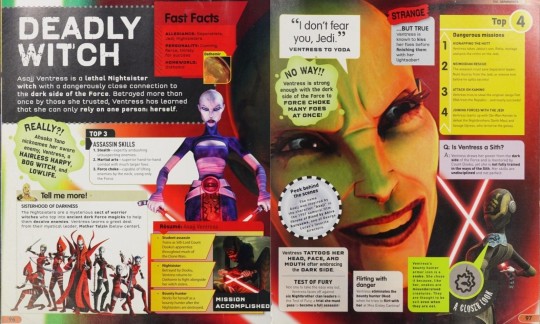

#disney star wars#star wars#star wars canon#star wars reference#star wars lore#boba fett#the grand inquisitor#darth sidious#darth vader#darth maul#qymaen jai sheelal#general grievous#grievous#kaleesh#asajj ventress#dathomirian#nightsisters
47 notes
·
View notes
Text
July 4, 2023
By Michael Kogge
(IndieWire) —Television archaeologists take note: you don’t need to dig deep into the medium’s origins to uncover a diamond in the rough. Treasures can be found in the recent past. And one of those treasures involves the greatest fictional archaeologist of them all, Indiana Jones.
On March 4, 1992, ABC premiered the two-hour movie pilot of “The Young Indiana Jones Chronicles” in its 8 p.m. slot to much fanfare. The show’s titular hero was a younger (and older) version of Harrison Ford’s blockbuster icon, who at 10, 17, and yes, 93, had his own set of primetime adventures. Since the series was the brainchild of filmmaker and franchise-builder George Lucas, outlets like USA Today, The Washington Post and The New York Times covered it extensively. Lucas wanted his “Chronicles” to do what movies couldn’t: tell one big story over 20 to 40 hours of programming. In today’s streaming landscape, that sounds perfectly conventional, yet in the era of 1990s’ network television, it was revolutionary.
Television archaeologists take note: you don’t need to dig deep into the medium’s origins to uncover a diamond in the rough. Treasures can be found in the recent past. And one of those treasures involves the greatest fictional archaeologist of them all, Indiana Jones.
On March 4, 1992, ABC premiered the two-hour movie pilot of “The Young Indiana Jones Chronicles” in its 8 p.m. slot to much fanfare. The show’s titular hero was a younger (and older) version of Harrison Ford’s blockbuster icon, who at 10, 17, and yes, 93, had his own set of primetime adventures. Since the series was the brainchild of filmmaker and franchise-builder George Lucas, outlets like USA Today, The Washington Post and The New York Times covered it extensively. Lucas wanted his “Chronicles” to do what movies couldn’t: tell one big story over 20 to 40 hours of programming. In today’s streaming landscape, that sounds perfectly conventional, yet in the era of 1990s’ network television, it was revolutionary.
Nonetheless, like so many highly anticipated shows, “Young Indiana Jones” failed to break into the cultural zeitgeist. ABC gave it a second season, out of goodwill to Lucas likely in hopes of future “Star Wars” material, yet the ratings couldn’t keep the show on the air. Over the years, the Chronicles occasionally surfaced on home video, but it’s never truly been given the due it’s deserved. Now that Disney+ has re-released the series along with the Indiana Jones feature films, viewers can watch Lucas’s grand vision of telling the history of the 20th century through the life of one man and make an assessment for themselves.
IndieWire recently spoke to the one actor who has spent more screentime in the role than even Harrison Ford: Sean Patrick Flanery, who played Indiana Jones during his formative years of 17 to 22 on the television series. Flanery relates how he nabbed the role, how the show continues to be one of the highlights of his career, and why it may have faded from the popular imagination.
#Indiana Jones#The Adventures of Young Indiana Jones#The Young Indiana Jones Chronicles#Sean Patrick Flanery#George Lucas#Lucasfilm#IndieWire
18 notes
·
View notes
Text
XIM WEEK
OKAY, so as I posted previously, I had to rearrange the order of the pieces about Xim the Despot as I found out I had placed some of them where I didn't want them (This is bound to happen when you have a general familarity with 90% of Legends canon but have not read it all, lol)
So here is the updated section as it is in my spreadsheet now:
Before Xim: The Pirate-King of Argai (Fry, Jason) - Pub. date 2012-12-08, Canon date c. 25,150 BBY - 25,130 (In: The History of Xim and the Tion Cluster)
The Despotica, Part II: The Pirate Prince (Kogge, Michael) - Pub. date 2009-12-09, Canon date c. 25,130 BBY (Hyperspace)
The Despot Triumphant (Fry, Jason) - Pub. date 2012-12-08, Canon date c. 25,130 BBY (In: The History of Xim and the Tion Cluster)
The Lost Thrones of Xim (Fry, Jason) - Pub. date 2012-12-08, Canon date c. 25,130 BBY (In: The History of Xim and the Tion Cluster)
War with the Hutts (Fry, Jason) - Pub. date 2012-12-08, Canon date c. 25,105 BBYThe (In: The History of Xim and the Tion Cluster)
Hero of Hutts (Kogge, Michael) - Pub. date 2009-12-08, Canon date c. 25,105 BBY (In Hyperspace - The Despotica: Part I)
Wise Investments (Kogge, Michael) - Pub. date 2009-12-08, Canon date c. 25,105 BBY (In Hyperspace - The Despotica: Part I)
Kossak's Trap (Kogge, Michael) - Pub. date 2009-12-08, Canon date c. 25,105 BBY (In Hyperspace - The Despotica: Part I)
Kossak's Trap: One... (Kogge, Michael) - Pub. date 2009-12-08, Canon date c. 25,105 BBY (In Hyperspace - The Despotica: Part I)
Kossak's Trap: ...Two... (Kogge, Michael) - Pub. date 2009-12-08, Canon date c. 25,100 BBY (In Hyperspace - The Despotica: Part I)
The Gleam of Kiirium (Kogge, Michael) - Pub. date 2013-12-03, Canon date c. 25,100 BBY
Kossak's Trap: Final Preperations (Kogge, Michael) - Pub. date 2009-12-08, Canon date c. 25,100 BBY (In Hyperspace - The Despotica: Part I)
Kossak's Trap: ...Three (Kogge, Michael) - Pub. date 2009-12-08, Canon date c. 25,100 BBY (In Hyperspace - The Despotica: Part I)
The Despotica, Part III: Xim at Vontor (Kogge, Michael) - Pub. date 2009-12-10, Canon date c. 25,100 BBY (Hyperspace)
Death of the Despot (Kogge, Michael) - Pub. date 2009-12-08, Canon date c. 25,100 BBY (In Hyperspace - The Despotica: Part I)
.... Did I just spend like 30 minutes formatting this like it's a bibliography in a jedikriffing thesis?
Yes. Yes, I did.
#star wars#star wars eu#star wars legends#a long time spent in a galaxy far far away#star wars challenge#star wars expanded universe#expanded universe#xim the despot#xim week#hyperspace
2 notes
·
View notes
Text
thoughts on Predator: Eyes of the Demon
overall not as ground breaking as I was hoping for (granted im a weird transsexual fag IRL so i guess i have a lot of expectations that are unlikely to be met by the average sci fi author), but still some decent stories! i'd say 6.5-7/10 overall. rating for each of the stories under the cut (to keep this post from being like. a mile long):
• "The Titans" by Tim Lebbon – underwhelming plot but i enjoyed their poetic rivalry. 6/10 • "The Distance in Their Eyes" by Stephen Graham Jones – good little story with a twist. Didn't think much of it at first but I keep thinking about it. 9/10 • "Aftermath" by Bryan Thomas Schmidt – ENOUGH. OF. DUTCH. let the poor guy rest! that being said, the way we get a tantalizing 3 paragraphs or so of "baby's first hunt" is SO charming. would have been more if it was focused on HIM not dutch but it was ALL about Dutch so. 3/10 • "Proving Ground" by Linda D. Addison – yautja-centric! and focusing on political maneuvering! yippee! sadly still kinda whatever. 7/10 • "Lion of the Himalayas" by Ammar Habib – human focused but a much needed change of setting and at least was unique. One of the better stories imo! 8.5/10 • "The Fix is In" by Jonathan Maberry – another capitalist-military future story (i hate this genre btw) but i'm obsessed with the single surviving yautja tricking a group of humans just to hijack their ship since his was irrevocably fucked. kudos to you, bro! 5.5/10 • "Bitter Hunt" by Kim May – this one just raised too many questions it didn't have the length to answer. why was your son going around killing women and children??? at least u killed him yourself. i would be sooooo embarrassed in her shoes. i would say if it got more space to flesh itself out, it could've been great. but this version we get is solidly a 6.5/10 • "Field Trip" by Robert Greenberger – THE INFAMOUS BIRTH AND NURSING STORY!!!!!! i think i have the most beef with the world building in this story out of all them. like. why the fuck were her novices such misogynists??? hello?????? like ZERO respect / understanding of reproduction. u were a baby once too you know?! funny setup, annoying teen boy type behavior, questionable mom choices too (if she didn't want to have da baby on earth then why sign up for this job so close to your due date?), but ultimately, the reason i chose this book in the first place. so 10/10 for getting me, keeping me, and making me mad. • "Cannon Fodder" by Gini Koch – girl power! would have been better if they were lesbians at the end. 6/10 • "Little Miss Nightmare" by Peter Briggs – I like this writer's style the most out of all the other authors featured. I thought his human characters were at least interesting. AND the yautja featured was more of an anthropologist vs being exclusively there to trophy people. so she had more curiosity. I think a lack of curiosity in people's yautja characters is the most disservice they can do to them. 9.5/10 • "The Trophy" by A.R. Redington – NOT HOW IT WOULD'VE GONE DOWN. TAKING LOTSA POINTS FOR THAT. 2/10 (objectively not a bad story. but makes me mad) • "The Monster" by Michael Kogge – hey I've been there! really funny to have bigfoot fight predator, but underwhelming-ly written. 6/10 • "Ghost Story" by Joshua Pruett – I suspect you are not a geologist. 5/10 • "Sly Dark in the Daylight" by Yvonne Navarro – really funny to have a Bad Blood be the main yautja in the story. human centric of course but at least it was a different setup than typical "yautja hunting humans" type thing. Kinda addicted to the ending but also not how it would've ended in my opinion. 6/10 • "Dead Man's Switch" by Scott Sigler – yeah yeah engineered super beast hunting facility attracts yautja. of course. 6/10
11 notes
·
View notes
Link
Grab your bookmarks, it’s time to take cover as we unleash the Canon Fodder over the Star Wars galaxy of literature. Join host Mark Newbold and our guest author Michael Kogge who joins us to discuss his work on the new John Carter of Mars audio drama. We delve into the project, the links to the GFFA as well as Michael's many works in the Star Wars galaxy on the latest episode of Canon Fodder. Remember to tune in to Good Morning Tatooine, LIVE Sunday evenings at 9.00pm UK, 4.00pm Eastern and 1.00pm Pacific on Facebook and YouTube and check out our Fantha Tracks Radio Friday Night Rotation every Friday at 7.00pm UK for new episodes of The Fantha From Down Under, Planet Leia, Desert Planet Discs, Start Your Engines, Collecting Tracks, Canon Fodder and special episodes of Making Tracks, and every Tuesday at 7.00pm UK time for your weekly episode of Making Tracks. You can contact any of our shows and send in your listeners questions by emailing [email protected] or comment on our social media feeds. Fantha Tracks Radio is the home of podcasts on FanthaTracks.com. You can contact any of our shows by emailing [email protected]; or comment on our social media on Twitter, Facebook, Instagram, TikTok, Pinterest, or Tumblr. Tune in on the platform of your choice below: Or find us on Smart Speakers such as Amazon Alexa, Apple HomePod, Google Home, and Sonos. We are also available in your car with Apple CarPlay and Android Auto, on your gaming console, and television; and of course you can find us on the Fantha Tracks App. For all the details on how to listen in and subscribe, check out our dedicated page for Fantha Tracks Radio. [amazon box="0593844211"]
0 notes
Text

PART THREE (of three) of the Prophet of the Church of Ezrabine’s analysis of the sacred canon text.



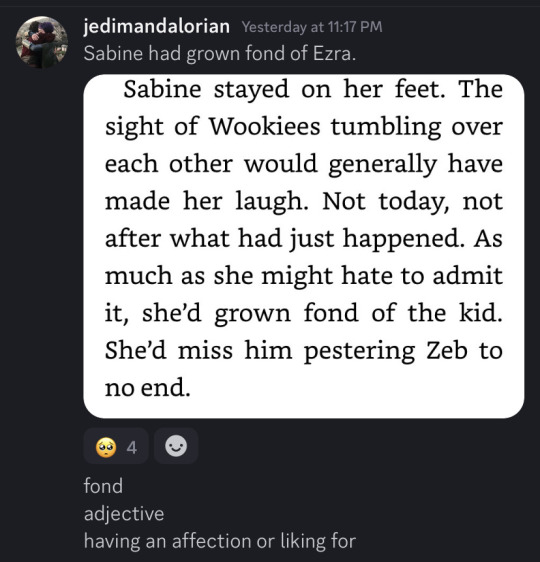
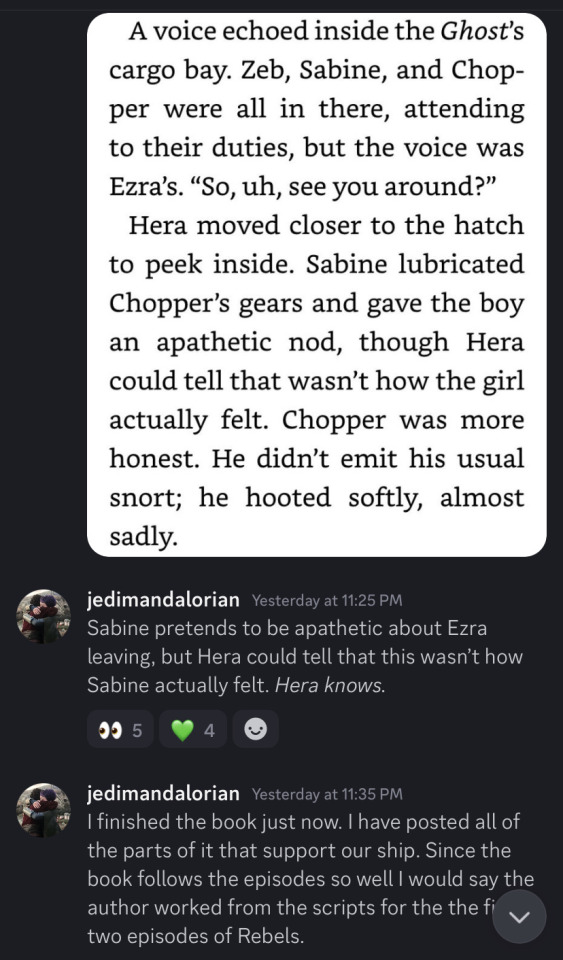
This is where it started.

Now we are here.


Sabezra isn’t a ship we made up during Rebels or during Ahsoka Season 1. It was there from their very first adventure together.
I have spoken.
Tag: Sabezra in the Rebellion Begins
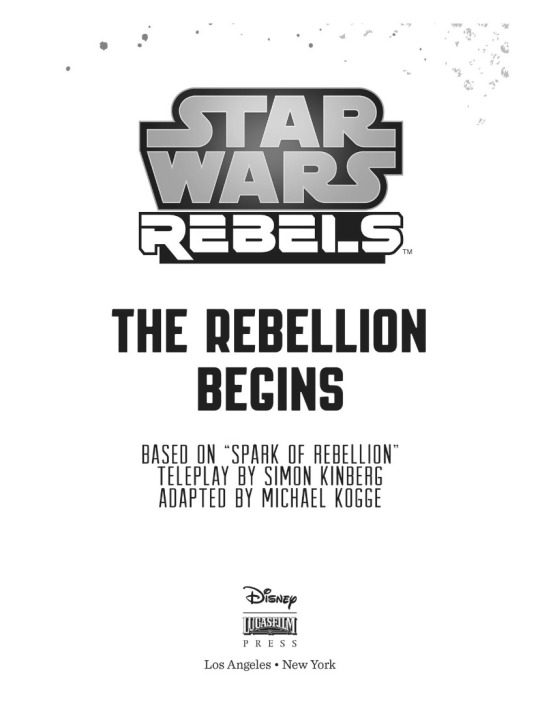
Thank you, Simon Kinberg and Michael Kogge!
#sabine wren#ezra bridger#star wars#ahsoka series#sabezra#star wars rebels#ezrabine#Sabezra in The Rebellion Begins
31 notes
·
View notes
Text
American Cinematographer - Unleashing Terror Through Lighting
I have delusions of maybe becoming a somewhat competent DOP one day. Right now, I’m not so good, mainly due to a lack of practice. Now that’s something I should NOT admit to in an academic blog. My big weakness for sure has to be lighting. This is definitely the aspect of filmmaking I need to divide a lot of my attention towards……and I WILL! Starting NOW! I decided to read this particular article in the American Cinematographer Magazine, not just because of its focus on lighting but specifically because it talks about lighting techniques found in the horror genre. Lighting is a complicated process in general but there seems to be even greater intricacies when it comes to horror. The genre often grants the DOP/director more creative freedom than the likes of a pure drama simply because there is less pressure with projecting reality as it is. The director’s job is to project reality through an unreality.
They impose techniques such as “strategically directional lighting, silhouettes, spotlighting, underexposure, projected shadows, and the creepy placement of practical sources”. They don’t need to obsess over reality because an unreality or altered reality is part of what makes the genre so effective. ASC member Roy H.Wagner specifically says, “In a movie, where the shadows are is where the audience doesn’t want to be” and, “What kind of person walks into a dark room and doesn’t reach for a light? But if you put the main character in the light and surround that person with shadows, the audience instinctively wants to know what’s going on in that darkness.”
The true effect of horror comes not from what the audience sees but what they don’t see. An audience’s biggest threat is their own imagination. This doesn’t just apply to characters being presented in dark spaces but can involve the presentation of the characters themselves. Deliberately hiding characters within shadows blocks the audience from fully understanding them. For example, a horror antagonist can be more threatening when the audience doesn’t fully understand their psychology and motives, when they’re so different to members of the audience.
Lighting and cinematography is incredibly important to Wagner as he condemns films that rely solely on the thrill of the jumpscare. He feels like they don’t take full advantage of the film medium and their methods force them to rely on post-production to deliver the fear.
He compliments films that use lighting to express a sense of space that’s different to the regular world. For example in The Exorcist where the scenes filmed downstairs use conventional lighting to present a sense of normalcy but when the characters go upstairs, everything is just darker, colder, the walls are green and blue and uninviting.
The lighting isn’t about representing reality but it’s about intention. It’s all about what the director wants the audience to know about characters, about their situations, about their emotions and vulnerabilities.
Other directors and cinematographers provide their own thoughts surrounding lighting within their horror films like Michael Kogge who talks about allowing darkness to invade the frame, focusing lighting on character’s eyes, which he believes tells the audience who the characters are.
Aaron Mclisky attempts to portray different spaces and worlds through the lighting. He specifically lit scenes for underexposed images, using a LUT to recover shadow detail, providing him with a lot of control over what he can display within the frame. The lighting is used to portray different spaces as personal or impersonal. Any scene set within reality has a realistic approach to lighting, whereas the supernatural is expressed through introducing ‘unmotivated’ lighting which provides the audience with the feeling that something isn’t quite right.
Michael Kogge says figuring out the cinematography and lighting is impossible until he has an understanding of the function of a scene, what purpose it plays within the larger film and the motivations and deeper emotions of the characters.
He also agrees that lighting for Horror ‘Has nothing to do with where you put the lights, it’s where you don’t put them”. Again, it’s going back to this idea that fear lies in the unknown. An audience’s imagination is their worst enemy.
While all these filmmakers have different approaches to how a story is presented, there is a lot of overlap. They all seem to agree that what is important is being incredibly particular with what information you relay to an audience, specifically they think about what not to show and audience to inspire fear. This article has given me a lot to think about. It seems that ultimately, cinematography and lighting present ideas and themes just as well as writing and directing.
0 notes
Text

Photo: Bekah Platzer + Thor Parker
Ticket sales for Legends Expo 2025 are available for purchase on our Square site at the Holiday Special rate! Through December, all ticket orders will include a sticker & personalized card so that you have something to physically gift the recipient!
Legends Expo is a fan-run convention celebrating the original Expanded Universe books, comics, games, and other media that are now known as Legends. Join us September 13th-14th 2025 in Burbank California!
#Jason Fry#Essential Guide To Warfare#Essential Atlas#Star Wars Lore#Star Wars Insider#Star Wars RPG#Star Wars Tales#Dark Horse Comics#Star Wars Hyperspace#Star Wars Gamer#Michael Kogge#Edge Of The Empire#West End Games#Fantasy Flight Games#Abel Pena#Henry Gilroy#Star Wars Books#Star Wars Comics#Star Wars Games#Star Wars Expanded Universe
4 notes
·
View notes
Text
Preview: Savage Sword of Conan #5 (of 6)
Savage Sword of Conan #5 (of 6) preview. The first chapter of an epic King Conan two-part comic from Jason Aaron! #comics #comicbooks
#comic books#Comics#dan parson#geof isherwood#heroic signatures#jason aaron#joe jusko#michael kogge#savage sword of conan#titan comics
0 notes
Text
Exercise 1 - Written
My Chosen article for this week was Unleashing Terror Through Lighting in October 2023 edition of ASC Magazine. I found the article really interesting as the directors explored in this article emphasise the importance of using the dark rather than the light in Horror films.
Director Wagner emphasises the importance of keeping a character scary by not fully revealing them on screen, using low exposure. He suggests that younger filmmakers often rely on old horror techniques, making horror films repetitive and predictable. Wagner advocates for creating psychological terror in horror films through lighting and other techniques. Wagner advocates for creating psychological terror in horror films through lighting and other techniques.
Another director who made use of the dark within horror was Tim Story and Todd A. Dos Reis. Dos Reis aimed to give the film a claustrophobic and dark feel, drawing inspiration from horror classics. Dos Reis aimed to give the film a claustrophobic and dark feel, drawing inspiration from horror classics. Dos Reis also used his experience working on music videos and TV shows to create the lighting and tone for the film.
Michael Kogge also explored the difficulties of lighting a horror film in this article. Cinematographer Michael Simmonds, known for the Halloween trilogy, is working on a new horror film, "The Exorcist: Believer," aiming to revitalize the original 1973 classic. Simmonds and the team aim to create a film that appeals to a broad audience by using unsettling techniques and visuals. He highlights the challenges of lighting for horror and the importance of leaving areas intentionally dark to convey violence and tone. The cinematography pays homage to the original Exorcist with vintage-style lenses and lighting techniques. Storytelling takes precedence over lighting continuity, and the focus is on conveying the narrative and mood according to Simmonds.
I found this article incredibly interesting as I have not often considered prioritising the dark over the light when it comes to filmmaking and how much of an effect it can have on a film to create one specific mood.
0 notes